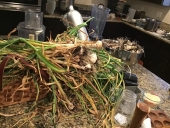
 3
3




 3
3




I make a Maple Syrup instructional movie! Check it out HERE
SKIP books, get 'em while they're hot!!! Skills to Inherit Property
See me in a movie building a massive wood staircase:Low Tech Lab Movie




 1
1




Don't let perfect be the enemy of good.
 4
4











 4
4




R Ranson wrote:For me, the thing that makes canning difficult is the safety concerns.
Pecan Media: food forestry and forest garden ebooks
Now available: The Native Persimmon (centennial edition)
 1
1




 1
1









"...specialization is for insects." - Lazarus Long
Universal Introduction to Permies
How Permies.com works

 5
5




Works at a residential alternative high school in the Himalayas SECMOL.org . "Back home" is Cape Cod, E Coast USA.
 3
3




 )))
)))








 1
1




Don't let perfect be the enemy of good.




 1
1








“The most important decision we make is whether we believe we live in a friendly or hostile universe.”― Albert Einstein









Works at a residential alternative high school in the Himalayas SECMOL.org . "Back home" is Cape Cod, E Coast USA.




"Rules without reason create rebellion"
 3
3








Country oriented nerd with primary interests in alternate energy in particular solar. Dabble in gardening, trees, cob, soil building and a host of others.
 1
1




 1
1




ErnestK




Joe
 1
1




Ernest Kestone wrote:Yeah, my first instinct also was to go with the scientifically proven method. As they say, live and learn.
Canning by the book is absurd. Foods will be either acidic, or overcooked until they're very poor nutritionally . Yes, botulism is always a possibility. But you have to nearly incinerate the food or leave it swimming in vinegar or citric acid.
Better to go with grandma's simple boiling water bath method. And then just heat thoroughly before eating.











Better to go with grandma's simple boiling water bath method. And then just heat thoroughly before eating.
"We're all just walking each other home." -Ram Dass
"Be a lamp, or a lifeboat, or a ladder."-Rumi
"It's all one song!" -Neil Young





 2
2




Works at a residential alternative high school in the Himalayas SECMOL.org . "Back home" is Cape Cod, E Coast USA.
 2
2








Mike Jay wrote:It depends on a few things. Would you be water bath canning (applesauce, tomatoes, jam/jelly) or pressure canning (meat, low acid food, beans, soup)? The equipment is much cheaper for water bath. If you have to buy all the gear new you're probably talking $100 for water bath and an additional $100 for a pressure canner. Most of the equipment can be shared between the two methods (funnels, grabbers, etc). You can get gear cheaper from garage sales or grandma's attic.
 1
1








Tom Rutledge wrote:Cheat like a cheetah fox. The easy way is so easy.
 wait for a natural pressure release , take out the jars.
wait for a natural pressure release , take out the jars.
 2
2




Don't let perfect be the enemy of good.









 1
1




S Tonin wrote:Botulism was so named after the Latin word for sausage; sausages were notorious in the past for being the source of outbreaks. People still ate them, and some died; then we figured out what was causing it and more or less eliminated the threat of botulism from improperly cured meats through the application of a few simple safety measures.
 1
1




 2
2




JayGee





Failure is a sign of activity and learning. It had nothing to do with under achievement
I never want to have a team member who has never failed - They are not doing!! 👍
 2
2





|
This tiny ad will self destruct in five seconds.
The new gardening playing cards kickstarter is now live!
https://www.kickstarter.com/projects/paulwheaton/garden-cards
|






